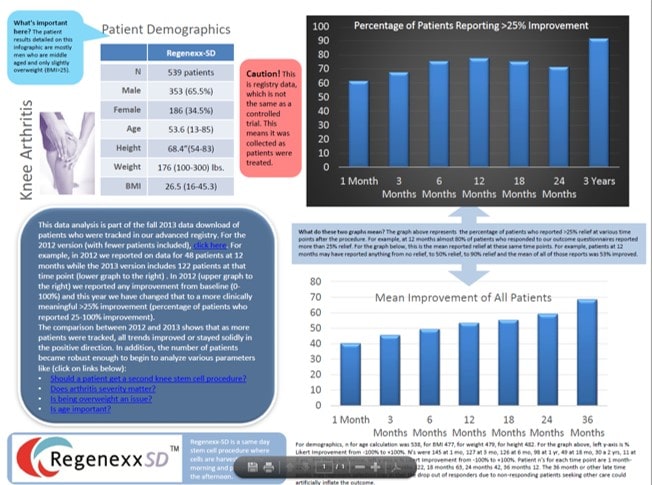Regenexx-SD Knee Stem Cell Procedure Data for 2013

Since the early 2012 version of this infographic we’ve gone from just under 200 same day knee cases being tracked to now more than 500 (this infographic has a link to last year’s). Just as last year, these patients are about 2 to 1 men, older in their 50’s, and slightly over weight. The percentage improvements that were only reported out to 18 months last year are now reported to 3 years. Also note that it’s very comforting how the overall reports in the 6-18 month range have stayed stable in the mid-50s, despite the number of patients reporting more than doubling. The continued improvements at 2 and 3 years are consistent with what we have seen in other procedures we have tracked. While the 2 year number of patients reporting is solid, I would caution anyone with hanging their hat on the three year reports yet until the number of patients reporting at that time frame gets bigger next year.
This year, instead of reporting any improvement from baseline (0-100%), I’ve reported on the percentage of all patients at each time point who had more than 25% improvement. I chose this cut off as I feel from examining and talking to hundreds of orthopedic stem cell patients that unless they report that they are at least 25% better, they don’t usually consider their progress as clinically significant.
What this data isn’t and how not to interpret it. This is data from our advanced treatment registry. It isn’t the same as a drug company style randomized controlled trial. While we’re recruiting for several of those including one beginning in Chicago for knee arthritis, this is important to note. In addition, when I report the mean improvement at a time point, for example 53%; this means that if all of the patients who reported at that time were averaged, their mean report was 53% better. It doesn’t mean that everyone should expect to feel 53% better by that time point. Finally, this data only applies to our proprietary three part stem cell procedure and doesn’t apply to all stem cell procedures being performed today for knee arthritis.
The upshot? Nobody has reported on more orthopedic stem cell data than Regenexx, period. This most recent knee data set tracked more than 500 knee patients for 3+ years and doesn’t include other body areas like hip, ankle, shoulder, etc…, that’s coming. This data set also doesn’t include cultured patients (just same day), that’s has already been published in the peer reviewed literature and an update is in the works. Like I have been saying for the last week, there’s the Regenexx procedure and then there’s stem cell guesswork. As always, the link to the new knee stem cell infographic is here or you can click on the thumbnail above.

If you have questions or comments about this blog post, please email us at [email protected]
NOTE: This blog post provides general information to help the reader better understand regenerative medicine, musculoskeletal health, and related subjects. All content provided in this blog, website, or any linked materials, including text, graphics, images, patient profiles, outcomes, and information, are not intended and should not be considered or used as a substitute for medical advice, diagnosis, or treatment. Please always consult with a professional and certified healthcare provider to discuss if a treatment is right for you.